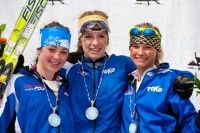March 13, 2011 (Minneapolis, MN) – Winter returned to Minneapolis in the form of temperatures in the low twenties, strong winds, and a trace of new snow. The course was firm-to-icy and the tracks were filled with the fresh drifting snow. Given the abrasive conditions, coaches tested a variety of klister or binder bases covered with waxes slightly warmer than the temperature. The savvy athletes double-poled out of the tracks and strided in the tracks. Coaches tried to find the balance between wax that wouldn’t shear off on the ice and wax that offered good glide on the dry snow that filled the tracks.
![J2 girls relay podium (l-r) New England 1, Alaska, New England 2. [P] davidjowen.com](http://skitrax.com/wp-content/uploads/2011/03/J2G-Podium-20110312-179-JO2011-ClRelay.jpg)
Given the very short racing length – 3×3 kilometers – speeds were very high and aggressiveness played a big role in the scramble leg. The course had one long and one short very fast downhill, each with a corner at the bottom. The athletes who were both fearless and skilled on their feet had the advantage.
![J2 boys relay - Midwest Team wins. [P] davidjowen.com](http://skitrax.com/wp-content/uploads/2011/03/J2B-Midwest-win-20110312-025-JO2011-ClRelay.jpg)
In the first race of the day, the J2 boys relay, New England’s scramble leg, Hamish McEwen, set the tone by taking an aggressive lead from the gun. McEwen and the other top skiers in the field double-poled out of the stadium between the many tracks. The remainder of the boys quickly caught on and also exited the tracks. Most then remembered to get back into the tracks for the climbs, but some forgot and were dropped instantly as they slipped.
![J1 boys relay podium (l-r): Midwest, Intermountain, Alaska. [P] davidjowen.com](http://skitrax.com/wp-content/uploads/2011/03/J1B-Podium-20110312-273-JO2011-ClRelay-200x133.jpg)
McEwen gained an 8-second lead over the course of his leg and tagged off to Ben Hegman. Hegman lost two seconds to the Midwest team, but still held the lead when tagging off to Tyler Foulkes. To the delight of the hometown crowd, the Midwest’s Harris Dirnberger skied an aggressive anchor leg, passing Foulkes and skiing the Midwest to a six-second win.
![J1 boys relay - the winning Intermountain team tags off. [P] davidjowen.com](http://skitrax.com/wp-content/uploads/2011/03/J1B-Intermountain-win-team20110312-219-JO2011-ClRelay-200x133.jpg)
Matthew Berntston, second leg for the Midwest, said the team had thought that they had a chance to win. “The goal of the first and second legs was just to keep up with the leaders. We hoped that Harris would beat out anyone.”
![The group during the J2 girls relay. [P] davidjowen.com](http://skitrax.com/wp-content/uploads/2011/03/J2G-Group-20110312-068-JO2011-ClRelay-200x133.jpg)
Unlike many Junior Olympic winners, Dirnberger has not been thinking about this day for a long time. “My first JO qualifying race was this winter. I went because I thought it would be fun to race the JOQ with my teammates. I did pretty well in the classic, so I kept going to the JOQs. I made the team, so here I am.”
![J2 girls relay - Team Alaska wins. [P] davidjowen.com](http://skitrax.com/wp-content/uploads/2011/03/J2G-Alaska-win-team-20110312-156-JO2011-ClRelay-200x300.jpg)
Dirnberger’s success isn’t surprising to his coach Piotr Bednarski of Go! Training, who first saw his talent this summer. “He first came to practices this summer. He surprised me by staying with an elite CXC skier in rollerski sprints.”

J2 Boys
1. Midwest (Nick Proell, Matthew Berntson, Harris Dirnberger)
2. New England (Hamish McEwen, Ben Hegman, Tyler Foulkes)
3. Intermountain (Noah Anderson, Karsten Hokanson, Marc Jackson)
![OJ boys relay podium (l-r): New England 2, New England 1, Alaska [P] davidjowen.com](http://skitrax.com/wp-content/uploads/2011/03/OJB-Podium-20110312-282-JO2011-ClRelay-200x133.jpg)
The J2 girls relay was also won on the last leg, when Alaska’s Marion Woods erased a 23-second deficit to pass New England for the win. Wood’s teammates were motivated by her successes this week. Sarrissa Lammers, the team’s scramble leg explained, “We really wanted to get Marion her four golds.”
![OJ boys relay - a close finish. [P] davidjowen.com](http://skitrax.com/wp-content/uploads/2011/03/OJB-Finish-20110312-246-JO2011-ClRelay-200x133.jpg)
Woods, for her part, still seems surprised by how well she finished this week. “I didn’t know what to expect coming down here. I knew a lot of people had been training a lot. I just planned to come to JOs and do my best.”
![OJ boys relay - the group together. [P] davidjowen.com](http://skitrax.com/wp-content/uploads/2011/03/OJB-Group-20110312-186-JO2011-ClRelay-200x133.jpg)
J2 Girls:
1. Alaska (Sarrissa Lammers, Mackenzie Flynn, Marion Woods)
2. New England 1 (Brooke Mooney, Cate Brams, Heidi Halvorsen)
3. New England 2 (Halie Lange, Zoe Snow, Hannah Benson)
![OJ girls relay - the group. [P] davidjowen.com](http://skitrax.com/wp-content/uploads/2011/03/OJG-Group-20110312-294-JO2011-ClRelay-200x133.jpg)
The J1s and OJs raced together, even though they were scored separately.
The New England OJ’s scramble leg, Skyler Davis, posted the fastest time of the first leg, but Intermountain’s J1 team scramble, Cole Morgan, remained in touch, five seconds behind and in second place.
Strong second legs were put in by Intermountain’s Sawyer Kesselheim and Midwest’s Dylan McGarthwaite, who were the only two skiers in the second leg to dip under nine minutes. Kesselheim caught New England OJ Peter Hegman and passed him on the long climb, going through the lap in the overall lead by one second. McGarthwaite’s strong leg pulled the team into second for J1s and fourth overall.
The anchor for Intermountain, Akeo Maifeld-Carucci, faced the daunting prospect of trying to keep up with David Sinclair, the winner in this week’s mens OJ classic. “Sinclair caught me early on, so I tried to stay with him as long as I could.” Maifeld-Carucci held on bravely, staying within five seconds Sinclair (New England OJ team) and bringing Intermountain in for the J1 victory with a 24-second margin over the Midwest J1 team. Carucci summed up his experience: “I had really good skis and super-strong teammates. It all came together for us.”
![OJ boys relay - The New England team on the way to victory. [P] davidjowen.com](http://skitrax.com/wp-content/uploads/2011/03/OJB-New-England-win-team20110312-231-JO2011-ClRelay-200x133.jpg)
J1 Boys:
1. Intermountain (Cole Morgan, Sawyer Kesselheim, Akeo Maifeld-Carucci)
2. Midwest: (Andy Dodds, Dylan McGarthwaite, Ben Saxton)
3. Alaska (Forrest Mahlen, Isaac Lammers, Logan Hanneman)
OJ Boys:
1. New England 1 (Skyler Davis, Peter Hegman, David Sinclair)
2. New England 2 (Austin Cobb, Chris Stock, Bridger Tyler)
3. Alaska (Jack Novak, Silas Talbot, Peter Mamrol)
The Minneapolis crowd looked forward to the finale of the weekend, the OJ/J1s girls race, knowing the Jessie Diggins would anchor the Midwest OJ team.
Diggins and her team did not disappoint. First and second legs, Libby Ellis and Elizabeth Simak, accomplished their plan of staying within reach of the leaders. Simak tagged off to Diggins in 2nd among OJs and 4th overall. As expected, Diggins made up the slack. She roared by the three teams in front of her, bringing the team in first overall, 23 seconds in front of the New England J1s.
Teammates Ellis and Simak were confident that if they held their own on the first legs, Diggins would make up any deficit. “Jessie is the most motivated person we have ever met. If she wants something, she goes out and gets it.”
Victory was especially sweet for this close-knit team. Ellis and Diggins have been skiing together for five years, while Simak been with them for four. The team raced the course with gold-glitter face decoration, a tradition the Midwest girls started at the 2006 Soldier Hollow JOs. Ellis explains that this is the perfect end for her and Diggins, who are both in their last year as older juniors. “It’s even better that this race is here in Minneapolis. I love the fans and appreciate all the hard work the organizers did to put this together.”
The New England OJ team of Heather Mooney, Cambria McDermott, and Corey Stock won the J1 relay, although they were pushed by the team from Rocky Mountain. Heather Mooney and Michaela Frias were neck-and-neck at the front of the pack throughout the scramble leg; Mooney had a 1-second lead at the tag. Mary O’Connell put the hammer down on her leg, and tagged off to Emily Hannah with an 11-second lead. The speed of Corey Stock, who was likely motivated by being passed by Diggins, was just too much for Rocky Mountain. Stock brought the team in for the J1 win and second-place overall.
Second-place in the J1s was a good result for team Rocky Mountain. They followed their race plan perfectly. For Frias, that plan was to “get the team in a good a position.” O’Connell’s role was to “push the pace high.” Hannah was determined “to try to stick with their position.” All three skiers are from Steamboat Springs High School, the public high school in the community of Steamboat Springs.
J1 Girls
1. New England (Heather Mooney, Cambria McDermott, Corey Stock)
2. Rocky Mountain (Michaela Frias, Mary O’Connell, Emily Hannah)
3. Alaska (Celia Haering, Tristan Ramey, Teagan Yutrzenka)
OJ Girls
1. Midwest (Elizabeth Ellis, Elizabeth Simak, Jessie Diggins)
2. Alaska (Mackenzie Kanady, Alyson McPhetres, Kinsey Loan)
3. New England (Anne Hart, Mary Cirelli, Isabel Caldwell)
Look for final Alaska Cup results and high school and club team standings to be posted HERE.
![Torin Koos [P] Kirk Nichols file photo](http://skitrax.com/wp-content/uploads/2013/01/Koos_4.2-200x262.jpg) January 21, 2013 (Minneapolis, MN) – Jennie Bender (CXC) and Torin Koos (Bridger Ski Foundation/Rossignol) scored the women’s and men’s wins, respectively, in the 15/20km Classic Mass start event, Stage 2 of round #4 of the 2013 USSA SuperTour’s Tour de Twin Cities at Wirth Park in Minneapolis, Minnesota on Sunday.
January 21, 2013 (Minneapolis, MN) – Jennie Bender (CXC) and Torin Koos (Bridger Ski Foundation/Rossignol) scored the women’s and men’s wins, respectively, in the 15/20km Classic Mass start event, Stage 2 of round #4 of the 2013 USSA SuperTour’s Tour de Twin Cities at Wirth Park in Minneapolis, Minnesota on Sunday.




![Matthew Liebsch (Team Strongheart/Team Birkie) [P] skitrax.com](http://skitrax.com/wp-content/uploads/2012/02/Matt-Liebsch-200x237.jpg)
![Mark Arendz (Can) [P] James Netz Photography file photo](http://skitrax.com/wp-content/uploads/2012/01/Mark-Arendz-Can-200x158.jpg)
![Garrott Kuzzy - You never know when you need a touch up! [P] Toko US](http://skitrax.com/wp-content/uploads/2011/03/kuzzytoko.jpg)
![Muffy Ritz cleaned up at the Masters WC - Congratulations! [P] Toko US](http://skitrax.com/wp-content/uploads/2011/03/muffy.jpg)
![The original relay trio; me, Lynn and Libby (I'm pleased to say none of us look as dorky anymore) [P] Jessie Diggins](http://skitrax.com/wp-content/uploads/2011/03/Original-trio.jpg)
![Elizabeth, Libby and Me. [P] Skinnyski](http://skitrax.com/wp-content/uploads/2011/03/Team.jpg)
![The mass start of the relay (Libby is on the right). Notice the hometown crowd! [P] Jessie Diggins](http://skitrax.com/wp-content/uploads/2011/03/Mass-start.jpg)
![My teammates were waiting for me just across the finish line! [P] Skinnyski](http://skitrax.com/wp-content/uploads/2011/03/Team-hug.jpg)
![My cousin Tony, Grandpa (Pepe), cousin Cal and my Mom. [P] Jessie Diggins](http://skitrax.com/wp-content/uploads/2011/03/Family.jpg)
![Getting a hug from my Pepe! [P] Jessie Diggins](http://skitrax.com/wp-content/uploads/2011/03/Pepe-hug.jpg)
![J2 girls relay podium (l-r) New England 1, Alaska, New England 2. [P] davidjowen.com](http://skitrax.com/wp-content/uploads/2011/03/J2G-Podium-20110312-179-JO2011-ClRelay.jpg)
![J2 boys relay - Midwest Team wins. [P] davidjowen.com](http://skitrax.com/wp-content/uploads/2011/03/J2B-Midwest-win-20110312-025-JO2011-ClRelay.jpg)
![J1 boys relay podium (l-r): Midwest, Intermountain, Alaska. [P] davidjowen.com](http://skitrax.com/wp-content/uploads/2011/03/J1B-Podium-20110312-273-JO2011-ClRelay-200x133.jpg)
![J1 boys relay - the winning Intermountain team tags off. [P] davidjowen.com](http://skitrax.com/wp-content/uploads/2011/03/J1B-Intermountain-win-team20110312-219-JO2011-ClRelay-200x133.jpg)
![The group during the J2 girls relay. [P] davidjowen.com](http://skitrax.com/wp-content/uploads/2011/03/J2G-Group-20110312-068-JO2011-ClRelay-200x133.jpg)
![J2 girls relay - Team Alaska wins. [P] davidjowen.com](http://skitrax.com/wp-content/uploads/2011/03/J2G-Alaska-win-team-20110312-156-JO2011-ClRelay-200x300.jpg)

![OJ boys relay podium (l-r): New England 2, New England 1, Alaska [P] davidjowen.com](http://skitrax.com/wp-content/uploads/2011/03/OJB-Podium-20110312-282-JO2011-ClRelay-200x133.jpg)
![OJ boys relay - a close finish. [P] davidjowen.com](http://skitrax.com/wp-content/uploads/2011/03/OJB-Finish-20110312-246-JO2011-ClRelay-200x133.jpg)
![OJ boys relay - the group together. [P] davidjowen.com](http://skitrax.com/wp-content/uploads/2011/03/OJB-Group-20110312-186-JO2011-ClRelay-200x133.jpg)
![OJ girls relay - the group. [P] davidjowen.com](http://skitrax.com/wp-content/uploads/2011/03/OJG-Group-20110312-294-JO2011-ClRelay-200x133.jpg)
![OJ boys relay - The New England team on the way to victory. [P] davidjowen.com](http://skitrax.com/wp-content/uploads/2011/03/OJB-New-England-win-team20110312-231-JO2011-ClRelay-200x133.jpg)
![OJ Women's podium (l-r) Kinsey Loan 2nd, Jessie Diggins 1st, Elizabeth Simak 3rd. [P] www.davidjowen.com](http://skitrax.com/wp-content/uploads/2011/03/OJ-Women-Top-3.20110307-187.jpg)
![J2 Women's Sprint Semis start. [P] www.davidjowen.com](http://skitrax.com/wp-content/uploads/2011/03/J2-Sprint-Semis-start-20110307-082.jpg)
![J2 girls top three... [P] www.davidjowen.com](http://skitrax.com/wp-content/uploads/2011/03/J2-girls-top-3.20110307-178.jpg)
![Logan Hanneman (Lathrop HS) added another win to a successful season. [P] www.davidjowen.com](http://skitrax.com/wp-content/uploads/2011/03/J1-Sprint-Finals-Logan-Hanneman-20110307-150.jpg)
![OJ Men's Sprint Quarterfinal action. [P] www.davidjowen.com](http://skitrax.com/wp-content/uploads/2011/03/OJ-Sprint-Quarters-20110307-020.jpg)
![Jessie Diggins did not disappoint. [P] www.davidjowen.com](http://skitrax.com/wp-content/uploads/2011/03/Jessie-Diggins.20110307-164.jpg)